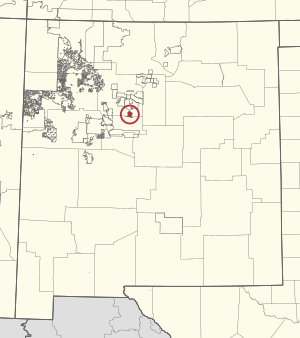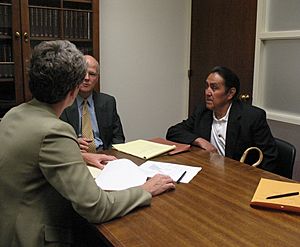Sandia Pueblo facts for kids

Location of Sandia Pueblo
|
|
| Total population | |
|---|---|
| 500–600 | |
| Regions with significant populations | |
| Languages | |
| Tiwa, English, Spanish | |
| Religion | |
| Roman Catholicism, traditional Pueblo religion | |
| Related ethnic groups | |
| other Pueblo peoples, Kiowa people |
Sandia Pueblo is a group of Native American Pueblo people. They live on a special area of land called a reservation in central New Mexico. This reservation is about 39 square miles (101 km²).
Sandia Pueblo is one of 19 Native American pueblos in New Mexico. It is known as one of the Eastern Pueblos. In 2010, about 427 people lived there. The people traditionally speak the Tiwa language. This language is part of the Tanoan group. However, fewer young people speak Tiwa today.
The Sandia Pueblo has its own government. This government runs businesses like the Sandia Casino. They also manage the Bien Mur Indian Market Center and Sandia Lakes Recreation Area. The government helps the Pueblo with business and political matters.
Contents
What Does "Sandia" Mean?
The Tiwa name for the Pueblo is Tuf Shur Tia. This means "Green Reed Place." It refers to the green forest area nearby. Some old papers say the first name was Nafiat. This Tiwa word means "Place Where the Wind Blows Dust."
The name Sandía came from the Spanish in the early 1600s. Sandía is the Spanish word for "watermelon". People have different ideas why it got this name. Some think a type of squash grown there looked like watermelons. Others believe explorers found a plant called sandía de culebra there.
The most common reason is about the Sandia Mountains. The Spanish called the mountain "Sandía" when they saw it at sunset. The mountains look red. The trees on them look like a green "rind" when the sun shines on them. This makes the mountain look like a sliced watermelon. The village closest to the mountain took its name. Over time, the name became simply Sandia Pueblo.
Where is Sandia Pueblo Located?
The Pueblo is about three miles south of Bernalillo. It is in southern Sandoval County and northern Bernalillo County. The city of Albuquerque is to the south.
The Sandia Mountains are to the east. These mountains are very important to the Sandia people. They are sacred and were key to their traditional way of life. A forest area called the bosque surrounds the rest of the reservation. This forest provides firewood and wild animals for hunting.
In 2014, the United States Congress passed a law. This law gave about 700 acres of land to the Sandia Pueblo.
A Look at Sandia Pueblo's Past
Ancient Times
The Pueblo culture grew between 700 and 1100 AD. This time saw new religious beliefs and a lot more people. From 1100 to 1300 AD was the Great Pueblo Period. During this time, Pueblo groups worked together. They also had important ceremonies in large Kivas.
The Sandia Pueblo has lived in its current spot since the 1300s. Back then, there were over 20 pueblos. It was a busy community with about 3,000 people. This was when Coronado arrived in 1539.
Meeting Europeans and Spanish Rule
Spanish explorer Francisco Vásquez de Coronado found the Pueblo of Sandía in 1539. He was looking for the "Seven Cities of Cíbola."
In 1610, a friar named Esteban de Perea came to the area. He was in charge of the friars in New Mexico. The Spanish made the Sandia Pueblo people pay taxes. They also made them work as slaves. They built churches and worked in Mexican mines.
Because of this unfair treatment, the Sandia people joined the Pueblo Revolt in 1680. This revolt was led by Popé. It drove the Spanish out of the area. But the Sandia people did not find true freedom. Popé and his leader Luis Tupatú also made them pay heavy taxes.
As a punishment, the Spanish governor ordered the village to be burned in August 1680. The Sandia people had left the village. They went to live with the Hopi people.
The Sandia people came back after each Spanish attack. In November 1742, 441 surviving Sandia people settled there for good. In 1762, Governor Tomás Cachupín ordered the Pueblo to be rebuilt. He wanted it to protect Albuquerque from raids by the Navajo and Apache.
Because of this, Sandia was often attacked. In 1775, a Comanche raid killed thirty people. The Sandia Pueblo became smaller over time. By 1900, only 74 people lived there.

Life in Mexico and the United States
Mexico took control of the area in 1820. This was after the Mexican War of Independence. It was hard for Mexico to control far-off lands. New Mexico had a short time where it was almost independent.
After the Mexican–American War in 1848, New Mexico became part of the United States. Zebulon Pike saw the Sandia Mountains in the 1800s. He called them the "San Dies."
When schools for Native Americans were built, Sandia students attended them. But American culture did not greatly change the tribe until World War II. During this war, eight young Sandia men died fighting for the country.
Sometimes, the tribal leaders have had disagreements with state and federal governments. They have tried to claim the Sandia Mountains to the east. They were strongly against building the Sandia Peak Tramway in 1966.
The tribe opened a casino in 1994. They have since made it bigger and added a hotel. The casino's outdoor theater hosts many shows. Its location near Albuquerque makes it popular for visitors.
Sandia Pueblo Culture
Religion and Beliefs
The Sandia people are very religious. Old reports talk about their devotion to santos. These are statues of saints. This is a mix of beliefs common in the Southwest.
Even though they are officially Catholic, they keep many of their old traditions. Their special celebration day is June 13. This is the feast day of St. Anthony. This celebration, called a fiesta, is open to everyone. Music and dance are a big part of the ceremony. It is a great honor to take part in it.
The Sandia Mountains are their official symbol.
Language Spoken
Today, English is the main language spoken in the Pueblo. But people often use Southern Tiwa and Spanish words too. Older people speak Southern Tiwa, Spanish, and English. However, younger people have not kept up with the traditional languages as much.
Many Spanish words are now used with an "American" accent. For example, horno (Spanish for "oven") is a ceramic outdoor oven still used today. Bosque (Spanish for "woods") is another example.
At Sandia, Southern Tiwa is still used in music, ceremonies, and daily life.
Images for kids
See also
 In Spanish: Pueblo de Sandía para niños
In Spanish: Pueblo de Sandía para niños









